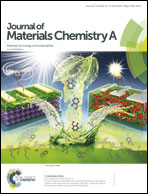Ultrathin NiCo2S4@graphene with a core–shell structure as a high performance positive electrode for hybrid supercapacitors†
Abstract
NiCo2S4 is a promising material for supercapacitors owing to its merits of high conductivity and activity in redox reactions. However it suffers poor cycling stability due to structural degradation of the electrode through the redox process. Herein we demonstrate a facile method for the synthesis of a NiCo2S4/graphene composite where NiCo2S4 is encapsulated with an ultrathin graphene layer to form a core/shell structure (NiCo2S4@G). Transmission electron microscopy (TEM) indicates that the shell is only 3–5 layers of graphene and the NiCo2S4 particle core has a uniform size of around 5–7 nm. The NiCo2S4@G composite exhibits excellent electrochemical performance with a specific capacitance of 1432 F g−1 at a current density of 1 A g−1. A hybrid supercapacitor assembled using the synthesized NiCo2S4@G as a positive electrode and porous carbon as a negative electrode demonstrates a high energy density of 43.4 W h kg−1 at a power density of 254.3 W kg−1 in the voltage range 0–1.35 V. After 5000 charge/discharge cycles, the device still retains 83.4% of its initial capacitance.



 Please wait while we load your content...
Please wait while we load your content...